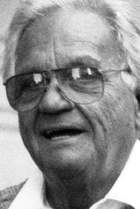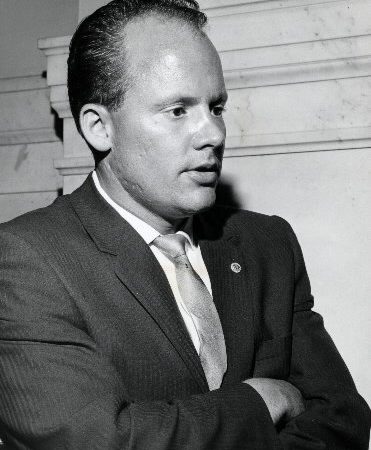Historic Detroiters Dave Johnson and Vito (Billy Jack) Giacalone have roles based on them in the highly-anticipated upcoming Martin Scorsese film The Irishman about the murder of Teamsters boss Jimmy Hoffa and his friendship with east coast hit man Frank (The Irishman) Sheeran. Johnson was Hoffa’s grizzled aid-de-camp in Motown during his reign atop the monolithic labor union, the president of Hoffa’s home base at Local 299. Giacalone was one of the Motor City’s most feared mob captains and along with his brother, “Tony Jack,” acted as Hoffa’s longtime contacts in the underworld.
Blaise Corrigan is cast as the gruff, broad-shouldered Johnson (pictured above), while Jai Stefan gets the nod as Giacalone. Stefan serves as one of the producers of the movie as well. Corrigan has made a name for himself in Hollywood over the last two decades as a stunt man, getting work on a number of Scorsese projects.
A character loosely based on Johnson appeared in the 1978 movie Blue Collar, starring Keitel and Richard Pryor as union workers in Detroit. Tony Jack Giacalone was the inspiration for the Carol (Dally) D’Allesandro character in the 1992 movie Hoffa featuring Jack Nicholson as Hoffa, missing since a lunch meeting with Tony Jack more than 43 years ago. Patrick Gallo plays Tony Jack in Scorsese’s Hoffa tale.
The Irishman will be released next year and is an on-screen adaption of the 2004 New York Times Best Selling book, I Hear You Paint Houses penned by Charlie Brandt. Sheeran, who ran a Teamsters branch in Delaware and worked directly for Pennsylvania mob dons Russell Bufalino and Angelo Bruno, claimed in the book that he shot Hoffa to death on the afternoon of July 30, 1975 in a Northwest Detroit residence on Bufalino’s orders. He died in the months prior to the book’s publishing. Federal authorities and most experts give Sheeran’s confession little weight. Many investigators and researchers point to Billy Giacalone as the real triggerman in the still-open homicide probe.
The Scorsese flick features a star-studded cast filled with cinematic icons. Robert DeNiro is playing Sheeran in the film. Joe Pesci plays Bufalino and Harvey Keitel portrays Bruno. All are famous for past collaborations with Scorsese, arguably America’s top director of the past 40 years. In his first collaboration with Scorsese, Al Pacino snatched the Hoffa role. Production wrapped in the late summer and Scorsese is rumored to have been allowed to shoot more than 300 scenes for the blockbuster Netflix has footed a 150 million dollar budget for and hopes to become a cultural touchstone like past Scorsese classics Goodfellas, Casino, Taxi Driver, The Departed, Raging Bull and Mean Streets.
Hoffa rose through the ranks of the Teamsters in Detroit and eventually became the labor union’s international president. At the peak of his power in the 1960s, the popular firebrand of a union boss was one of the most recognizable and influential men in the country. But Hoffa was in bed with the mob and that relationship, although sky-rocketing him to meteoric heights politically, proved his ultimate downfall.
Imprisoned in 1967 for bribery and jury tampering, Hoffa relinquished his presidency to his No. 2 Frank (Big Fitz) Fitzsimmons in the coming years in return for a pardon from the Nixon White House. The mob preferred the easier-to-manipulate Fitzsimmons to the hard-charging, difficult-to-rein-in Hoffa anyway.
However, upon his hitting the streets again, Hoffa wanted his job back and despite warnings from his former mafia benefactors to stay on the sidelines, he set out on a mission to win the 1976 union election. Fitzsimmons also made a play to take control of Local 299 in Southwest Detroit, a Hoffa stronghold for decades, by having his son Richard (Little Fitz) Fitzsimmons to run in the ’76 election against staunch Hoffa loyalist Dave Johnson.
For months leading up to Hoffa’s disappearance, violence rang out in Detroit, as a mob-backed Teamsters-employed “goon squad” waged war against Hoffa’s campaign and his most relied-upon allies in Michigan. Johnson’s office windows were riddled with bullets in a drive-by shooting and his boat was blown to pieces in an explosion outside his summer cottage on Grosse Ile island. Little Fitz’s car was bombed outside Nemo’s Bar, a frequent Local 299 after-work gathering spot, in early July 1975.Three weeks later, Hoffa vanished.

Billy Giacalone
The Giacalone brothers were the faces of the Detroit mafia in the second half of the 20th Century, the Zerilli-Tocco crime family’s street bosses and junkyard dogs. Hoffa disappeared en route to a lunch date with Tony Giacalone at a Bloomfield Township, Michigan restaurant on July 30, 1975 to discuss union business and help square a beef Hoffa was in with an east coast mobster and union boss related to Giacalone via marriage.
Billy Giacalone was unaccounted for by his regular FBI surveillance unit for most of the day Hoffa went missing, having ditched his tail that morning. Both Giacalones would go to prison in subsequent years for crimes unrelated to the Hoffa case. Tony Jack died of kidney failure in 2001. Billy Jack eventually became the crime family’s underboss and died of natural causes in retirement in 2012.
The post New Scorsese Movie Has Dave Johnson & Billy Giacalone Characters, Supergroup Hoffa Pic In Post Production appeared first on The Gangster Report.


